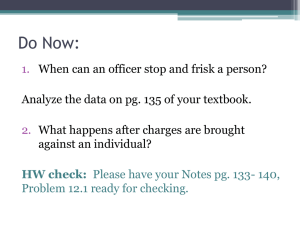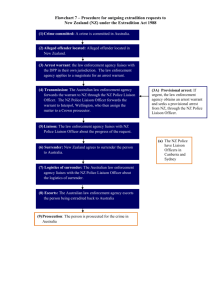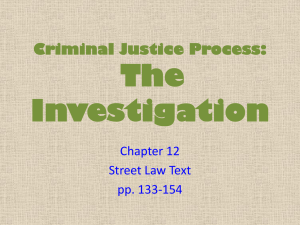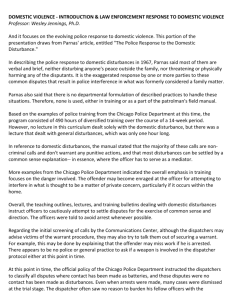Nowlin Word case chart
advertisement
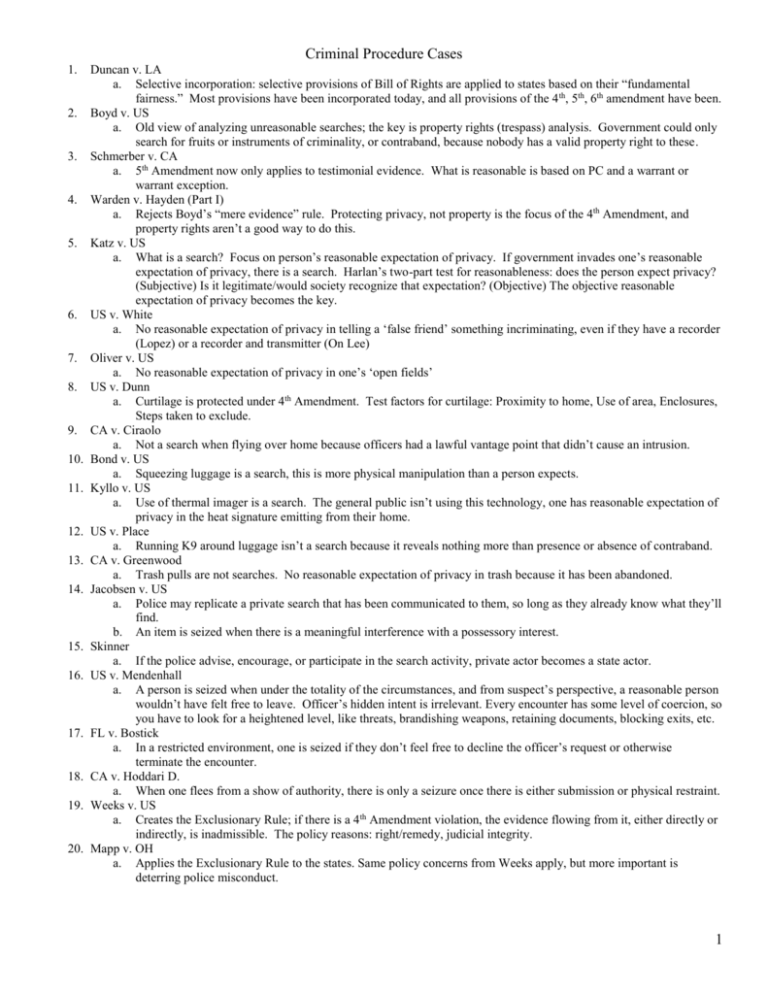
Criminal Procedure Cases 1. 2. 3. 4. 5. 6. 7. 8. 9. 10. 11. 12. 13. 14. 15. 16. 17. 18. 19. 20. Duncan v. LA a. Selective incorporation: selective provisions of Bill of Rights are applied to states based on their “fundamental fairness.” Most provisions have been incorporated today, and all provisions of the 4 th, 5th, 6th amendment have been. Boyd v. US a. Old view of analyzing unreasonable searches; the key is property rights (trespass) analysis. Government could only search for fruits or instruments of criminality, or contraband, because nobody has a valid property right to these. Schmerber v. CA a. 5th Amendment now only applies to testimonial evidence. What is reasonable is based on PC and a warrant or warrant exception. Warden v. Hayden (Part I) a. Rejects Boyd’s “mere evidence” rule. Protecting privacy, not property is the focus of the 4th Amendment, and property rights aren’t a good way to do this. Katz v. US a. What is a search? Focus on person’s reasonable expectation of privacy. If government invades one’s reasonable expectation of privacy, there is a search. Harlan’s two-part test for reasonableness: does the person expect privacy? (Subjective) Is it legitimate/would society recognize that expectation? (Objective) The objective reasonable expectation of privacy becomes the key. US v. White a. No reasonable expectation of privacy in telling a ‘false friend’ something incriminating, even if they have a recorder (Lopez) or a recorder and transmitter (On Lee) Oliver v. US a. No reasonable expectation of privacy in one’s ‘open fields’ US v. Dunn a. Curtilage is protected under 4th Amendment. Test factors for curtilage: Proximity to home, Use of area, Enclosures, Steps taken to exclude. CA v. Ciraolo a. Not a search when flying over home because officers had a lawful vantage point that didn’t cause an intrusion. Bond v. US a. Squeezing luggage is a search, this is more physical manipulation than a person expects. Kyllo v. US a. Use of thermal imager is a search. The general public isn’t using this technology, one has reasonable expectation of privacy in the heat signature emitting from their home. US v. Place a. Running K9 around luggage isn’t a search because it reveals nothing more than presence or absence of contraband. CA v. Greenwood a. Trash pulls are not searches. No reasonable expectation of privacy in trash because it has been abandoned. Jacobsen v. US a. Police may replicate a private search that has been communicated to them, so long as they already know what they’ll find. b. An item is seized when there is a meaningful interference with a possessory interest. Skinner a. If the police advise, encourage, or participate in the search activity, private actor becomes a state actor. US v. Mendenhall a. A person is seized when under the totality of the circumstances, and from suspect’s perspective, a reasonable person wouldn’t have felt free to leave. Officer’s hidden intent is irrelevant. Every encounter has some level of coercion, so you have to look for a heightened level, like threats, brandishing weapons, retaining documents, blocking exits, etc. FL v. Bostick a. In a restricted environment, one is seized if they don’t feel free to decline the officer’s request or otherwise terminate the encounter. CA v. Hoddari D. a. When one flees from a show of authority, there is only a seizure once there is either submission or physical restraint. Weeks v. US a. Creates the Exclusionary Rule; if there is a 4th Amendment violation, the evidence flowing from it, either directly or indirectly, is inadmissible. The policy reasons: right/remedy, judicial integrity. Mapp v. OH a. Applies the Exclusionary Rule to the states. Same policy concerns from Weeks apply, but more important is deterring police misconduct. 1 21. IL v. Gates a. Instead of Spinelli/Aguilar test, probable cause is determined by totality of the circumstances, with an eye to veracity and basis of knowledge, but not as a rigid two-part test. Police & magistrates are able to easily apply a common sense test, anything more would be unrealistic. 22. US v. Ventresca a. Standard for PC determination of magistrate is less demanding than that of police officer. 23. Whren v. US a. If there is PC of a traffic violation, the stop is valid, regardless of subjective motivation of the officer. 24. Warden v. Hayden (Part II) a. Concerns about safety and destruction of evidence routinely give rise to exigencies that obviate the need for a search warrant. Officer must have ‘reasonable basis for belief’ that there is an exigency. The scope of the search in an exigency extends to anywhere man or weapon may be hidden, and police may look until they are satisfied they won’t find what they are looking for. 25. Vale v. LA a. Police may not bypass the opportunity to obtain a search warrant & create their own exigency. 26. IL v. MacArthur a. Okay to seize a house & exclude home owner while obtaining a search warrant. 27. Chambers v. Maroney a. With probable cause, police may seize the car then search it, or they may search without a warrant. This is a special rule linked to exigency. 28. Carney v. CA a. If a vehicle has a reasonable appearance of ready mobility & transportation use, it falls into automobile exception. 29. US v. Chadwick a. No automobile exception equivalent for luggage & mobile effects outside vehicle. 30. CA v. Acevedo a. Creates remedial rule after confusing cases—does automobile exception apply to the container if the PC is for the car, vice versa. The solution—automobile equals automobile warrant exception. 31. WY v. Houghton a. Ownership of property in a vehicle isn’t material. All property is subject to search under the exception. 32. US v. Watson a. No warrant needed for a felony arrest made in public, or a misdemeanor arrest in public that is committed in officer’s presence, meaning observable to the officer’s five senses. 33. Gerstein a. There must be a judicial hearing on the PC for arrest, either before arrest or immediately after. 34. McLaughlin a. Gerstein hearing must be within 48 hours absent exigency. If there’s no hearing, there is a 4 th amendment violation. 35. Atwater a. Full custodial arrests for minor (fine only) offenses are valid if officer is authorized by state law to arrest. 36. Chimel v. CA a. Search incident to arrest must be substantially contemporaneous with arrest and it is limited to the ‘wingspan’ of the arrestee. 37. US v. Robinson a. No quantum of suspicion is required for search incident to arrest; it flows naturally from the arrest. But search incident to arrest isn’t a warrant exception because no PC is required. 38. NY v. Belton a. Valid arrest + occupant or recent occupant of vehicle = police may search the entire passenger compartment of the vehicle. They may only search the trunk if it is accessible from passenger compartment. 39. US v. Thornton a. Police don’t have to initiate contact with suspect while they are still in their vehicle before Belton applies. 40. Payton v. NY a. An arrest warrant and PC that person is in home is required to enter one’s home for a felony arrest. 41. US v. Steagald a. If arrestee is in 3rd party’s home, both search warrant and arrest warrant required. 42. MD v. Buie a. If there is an arrest in a home, police may do a protective sweep (cursory visual inspection) for persons hiding who may pose a threat to police. No quantum of suspicion is required for spaces immediately adjoining the place of arrest. Beyond that, reasonable suspicion is needed. 43. Terry v. OH a. A stop & frisk is a search and it is a seizure. Terry stop & frisk requires reasonable suspicion that crime is afoot (stop) and that the person is armed (frisk). Police need some restrictions, but requiring PC would hinder crime control and officer safety. Terry is a warrant exception and a PC exception. The test is totality of circumstances. 2 b. 44. 45. 46. 47. 48. 49. 50. 51. 52. 53. 54. 55. 56. 57. 58. 59. 60. 61. 62. 63. 64. 65. 66. The scope of a Terry frisk is limited to a pat down of the outer clothing to confirm or dispel the suspicion that the person is armed. If the officer can’t confirm or dispel the suspicion, they may remove the item and examine it. Once they dispel the suspicion, the search is over. IL v. Wardlow a. Reasonable suspicion has no per se rule. AL v. White a. Apply Gates test to Terry stops based on tips. Also assumes it is okay to ask for consent search during Terry stop of vehicle. FL v. J.L. a. No firearm exception to reasonable suspicion, but there may be a bomb exception. US v. Arizu a. Reaffirmed that there is no per se rule for reasonable suspicion. Hensley a. Reasonable suspicion applied to past criminal behavior; if crime is a felony, Terry is okay. Misdemeanors haven’t been clarified, but if they are recent they are probably okay too. MI v. Long a. Terry extends to passenger compartment of vehicle in certain situations. Limited to the areas where a weapon may be placed. Reasonable suspicion still required. Hiibell v. NV a. A person is compelled to provide their name to an officer making a Terry stop if it is reasonably related to the circumstances justifying the stop. PA v. Mimms a. Police may order driver out of vehicle MD v. Wilson a. Police may order passengers out of vehicle. IL v. Caballes a. Police may run K9 around a vehicle during traffic stop so long as it doesn’t lengthen the time of the stop. Ybarra v. IL a. No blanket search of everyone present at place where search warrant executed. Richards v. WI a. To justify a no-knock entry, police must have reasonable suspicion that under the circumstances, the knock & announce would be dangerous or futile. MI v. Summers a. It is permissible to detain a resident/occupant of a home that is present at time of executing search warrant. IL v. Lafayette a. Requirements for an inventory search are: valid arrest, arrestee subject to incarceration, standard operating procedure. The SOP doesn’t have to be written somewhere, but if it isn’t followed the search may be invalid. CO v. Bertine a. Requirements for inventory search of vehicle are directly analogous to those for a person: valid impoundment, vehicle subject to impoundment, SOP. MSP v. Sitz a. Checkpoints without individualized suspicion for DUI are constitutional. Determine reasonableness through Brown balancing—level of intrusion against state interest & degree the checkpoint advances that interest. Indianapolis v. Edmond a. Adds the requirement that the checkpoint can’t be for ordinary crime fighting purposes, it has to have a nexus to highway (or border if border checkpoint). Courts will check for a programmatic pretext to checkpoints. Schneckloth v. Bustamonte a. Consent for a consent search must be voluntary, as determined by the totality of the circumstances. State doesn’t have to show that the person knew they could refuse consent. Consent is not a waiver of the 4 th amendment, because the search still has to be reasonable. OH v. Robinette a. Police aren’t required to tell someone they are free to go before asking for a consent search. If the consent search stems from an unlawful detention, then the exclusionary rule applies. Officer has a reasonable amount of time to ask for the consent search. FL v. Jimeno a. Scope of consent search is limited to what the officer reasonably believed the scope to be. US v. Matlock a. If you share your privacy with a cotenant, you assume the risk that they will consent to a search. GA v. Randolph a. If there is a dispute of consent between cotenants, the person not consenting must be present. IL v. Rodriguez 3 a. If police believe that the consenting party has authority to consent, the consent is valid. We don’t require that they be right, only reasonable. 4 67. Horton v. CA a. There is no inadvertence requirement to plain view. All that is required is that police have a lawful vantage point, lawful right of access and it must be immediately apparent that the item is subject to seizure due to its association with crime. 68. MN v. Dickerson a. “Plain touch” doctrine, during a frisk an officer may seize an item that he realizes is contraband if he learns that at the instance he realizes it is not a weapon. 69. TN v. Garner a. Officer may use deadly force on a fleeing felon when they have PC that the suspect poses a threat of death or serious physical harm and a reasonable belief that the force is necessary to subdue the person; must be a warning if feasible. 70. Graham v. Connor a. Excessive force not reaching the level of deadly force is an unreasonable seizure. Use of seizure is examined under totality of the circumstances; factors include nature of crime, resistance, fleeing. 71. Rakas v. IL a. Overrules “standing” analysis of who can assert a 4th amendment defense, replaces it with personal rights approach. If person had a reasonable expectation of privacy, they may seek the exclusion of the evidence. 72. Rawlings v. KY a. Gives analysis that was implicit in Rakas; if one has a privacy interest they can object to a search. If one has a possessory interest, they may object to the seizure. 73. MN v. Olson a. Overnight guests have a reasonable expectation of privacy. 74. MN v. Carter a. People at a residence for business purposes don’t have a reasonable expectation of privacy. 75. Murray v. US a. To analyze the “genuine independence” of an independent source, make sure the motivation for the 2 nd search was not based on the illegal search, and nothing learned in the illegal search can be necessary for the PC determination for search warrant. 76. Nix v. Williams a. Inevitable discovery rule: severs "but for" causation in fruit of the poisonous tree analysis. Rule functions as a hypothetical independent source and officers must prove by preponderance of the evidence that evidence from illegal source would have been discovered anyway; no requirement of inevitable discovery. 77. Brown v. IL a. Miranda warning alone doesn’t break the chain flowing from an unlawful arrest. 78. US v. Ceccolini a. Taint attenuates faster for testimonial evidence than physical evidence. 79. Hudson v. MI a. New theory of attenuation, “by mismatch”. If the interest protected by the Constitutional guarantee is not served by suppression of the evidence, then evidence won’t be suppressed. Look for a mismatch of the violation and the evidence. 80. Segura a. Dicta says there is no constitutional right to destroying evidence. If the only causation connection is that the police prevented defendant from destroying evidence, then attenuation kicks in. 81. US v. Leon a. Good faith exception—if officers rely in good faith on magistrate’s PC decision that later turns out to be invalid, the evidence doesn’t have to be suppressed unless; magistrate abandoned their judicial role, officer puts false info before magistrate, no indicia of PC, warrant is facially deficient. Good faith exception is only to the exclusionary rule, not to the 4th amendment. 82. IL v. Krull a. Good faith exception like Leon for reliance on a statute that is later declared unconstitutional. 83. AZ v. Edwards a. Good faith exception for reliance on a clerk, so long as filing system is reasonably accurate. 84. US v. Havens a. Illegally seized evidence may be used to impeach defendant’s testimony on direct or cross exam. 85. James v. IL a. Declines to extend Havens to defendant’s witnesses. 86. Ashcraft v. TN a. Voluntariness of suspect’s statement is determined by totality of circumstances, but 36 hour relay interrogation will render statement involuntary. 5 87. Miranda v. AZ a. A custodial interrogation triggers the requirement of Miranda. This serves to dispel the coercive atmosphere. Any statement made in this atmosphere is presumed involuntary and is inadmissible. 88. Berkemer v. McCarty a. Full custodial arrest or its functional equivalent = custody. Terry stops & traffic stops are not custody for Miranda. 89. RI v. Innis a. Express question or its functional equivalent = interrogation. Is the statement “Something the officer should reasonably know is reasonably likely to elicit a response”? 90. IL v. Perkins a. Undercover officer posing as prisoner is not a custodial interrogation. The suspect must know they are talking to the police. 91. Johnson v. Zerbst a. Miranda waiver must be knowing & intelligent, as tested by totality of the circumstances. 92. MI v. Mosley a. After suspect invokes their Miranda right to silence, the police must show that they scrupulously honored the invocation before interrogation may resume. 93. AZ v. Edwards a. After suspect invokes their Miranda right to counsel, police may not initiate interrogation outside presence of counsel. 94. Roberson a. No exception to Edwards for different crimes. 95. Davis v. US a. Invocations of right to counsel must be unambiguous. If the request isn’t, the police may ignore it. 96. OR v. Bradshaw a. Initiation is, “Something, though ambiguous, that evinces a desire for a general discussion of the investigation.” Ambiguity of statements is resolved against suspect. 97. NY v. Quarles a. Public safety exception to Miranda. 98. Massiah v. US a. Formal judicial proceedings and interrogation (deliberate elicitation) requires the presence of an attorney to ensure a fair trial and balance adversarial process. 99. US v. Henry a. Deliberate means, “Deliberately or intentionally creating a situation where a person is likely to make an incriminating statement.” 100. Kuhlman v. Wilson a. Elicitation is more than passive listening. It is some kind of stimulation of statements or a trust relationship that is abused. 101. Patterson a. Miranda warning is sufficient warning for one to waive their 6 th Amendment right to counsel. 102. MI v. Jackson a. Once right to counsel is asserted after person has been charged with a crime, police can’t interrogate outside presence of counsel. 103. TX v. Cobb a. Jackson rule is offense specific, and the elements of the crime have to be related. (Is one a lesser included offense?) 104. Harvey a. If the only bar to admission of a statement is the Jackson rule, the statement may be used for impeachment. 6


